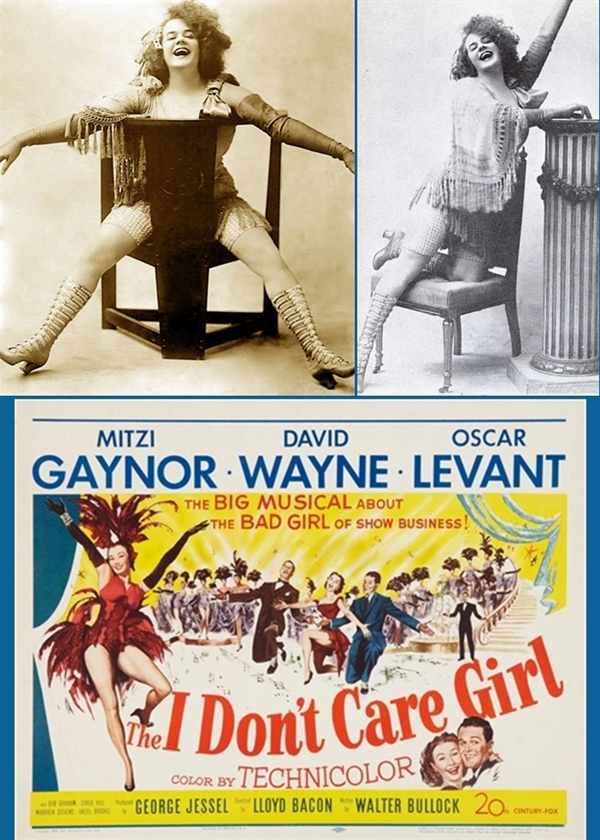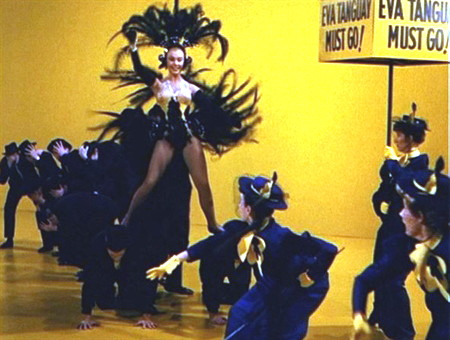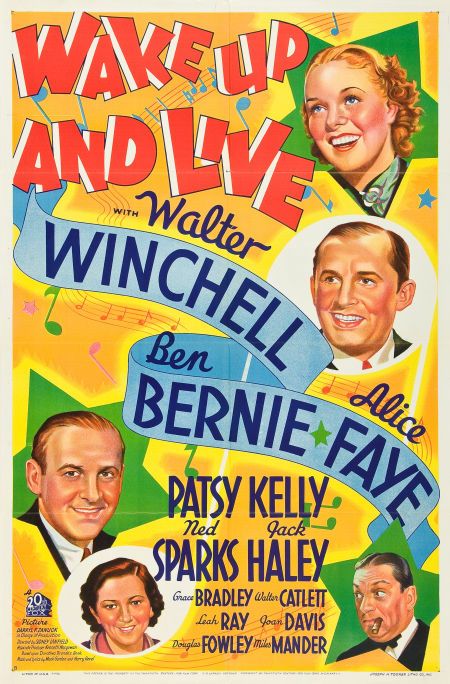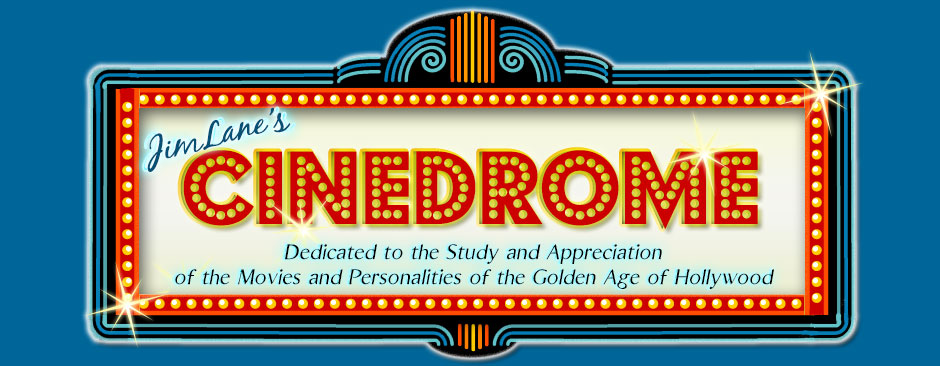Cinevent 51 — Day 2
 Friday morning at Cinevent started off bright and early with one of the last of 20th Century Fox’s fanciful biopics of figures from the Golden Age of Vaudeville. Earlier years had seen highly fictionalized treatments of the lives of Lillian Russell (1940), songwriter Paul Dresser (My Gal Sal, 1942), The Dolly Sisters (1945), another songwriter, Joe Howard (I Wonder Who’s Kissing Her Now, 1947), Florodora girl Myrtle McKinley (Mother Wore Tights, 1947), Lotta Crabtree (Golden Girl, 1951) and even John Philip Sousa (Stars and Stripes Forever, 1952). Today’s specimen of the sub-genre was The I Don’t Care Girl (1953), starring Mitzi Gaynor as “the Queen of Vaudeville” Eva Tanguay. And here I’m going to detour into a brief consideration of Eva Tanguay herself, because the truth is she’s vastly more interesting than the movie Fox and producer George Jessel made about her.
Friday morning at Cinevent started off bright and early with one of the last of 20th Century Fox’s fanciful biopics of figures from the Golden Age of Vaudeville. Earlier years had seen highly fictionalized treatments of the lives of Lillian Russell (1940), songwriter Paul Dresser (My Gal Sal, 1942), The Dolly Sisters (1945), another songwriter, Joe Howard (I Wonder Who’s Kissing Her Now, 1947), Florodora girl Myrtle McKinley (Mother Wore Tights, 1947), Lotta Crabtree (Golden Girl, 1951) and even John Philip Sousa (Stars and Stripes Forever, 1952). Today’s specimen of the sub-genre was The I Don’t Care Girl (1953), starring Mitzi Gaynor as “the Queen of Vaudeville” Eva Tanguay. And here I’m going to detour into a brief consideration of Eva Tanguay herself, because the truth is she’s vastly more interesting than the movie Fox and producer George Jessel made about her.
In his notes for The I Don’t Care Girl, Richard Barrios compares Eva Tanguay (1878-1947) to Madonna; others have compared her to Lady Gaga. Like those two (the comparison goes), Tanguay parlayed a modest (even routine) song-and-dance talent into superstardom by encasing it in outlandish costumes and outrageous behavior on and off stage. That’s fine as far as it goes, even astute, but it’s interesting that we have to reach 80, even 100 years into Tanguay’s future for comparisons. In 1904, when she made her first big splash, there was simply nothing to compare her to.
The two photos I’ve posted here give a remote idea of her personality on stage. Her outrageousness, too: The picture on the left has an aura of, shall we say, frank invitation that in 1905 must have had men all over America heading straight from the theater to their cold showers. (And these are only a sample; do a Google Images search for her and you’ll find dozens more.) The titles alone of her signature songs further underline her feverish effect: “I Don’t Care”, of course; also “It’s All Been Done Before But Not the Way I Do It”, “I Want Someone to Go Wild With Me”, “Go As Far As You Like”. Critics and audiences alike stood flabbergasted, not knowing what the hell to make of her, and they loved her for it — or more likely, decided that resistance was futile. Even the occultist crackpot Aleister Crowley said he found her “like the hashish dream of a hermit who is possessed of the devil”, then went on to say: “I could kill myself at this moment for the wild love of her.” For a sharp appraisal of Eva Tanguay’s place in showbiz history, click over to the Slate archive for 2009 and read “Vanishing Act: In search of Eva Tanguay, the first rock star” by Jody Rosen.
If you’ve read Jody Rosen’s article, and if you’ve seen The I Don’t Care Girl, then you have an inkling of what a near-total botch the movie is. Rosen calls it “clunky”; she minces words. Closer to the truth were vaudeville historian Anthony Slide, who called it “dismal”, and Clive Hirschhorn in The Hollywood Musical, who said the main problem was Walter Bullock’s “really lousy script”. The sad part is that 1953 was pretty much the last time that it was possible to make a movie that could have captured Eva Tanguay’s appeal (the way Yankee Doodle Dandy, for all its fiction, captured George M. Cohan’s). In 1953 her heyday was still well within living memory; producer George Jessel very likely knew her personally. Director Lloyd Bacon might have as well.
 Not that it would have been easy. The Production Code was still in firm control, and Eva Tanguay’s main selling point was blatantly sexual, a lusty throwing off of the prim strictures of Victorian ladyhood (Rosen says that her dances frequently looked like simulated orgasms), where Cohan’s chief selling point was patriotism, much easier to get through the Breen Office (especially during a war). But it could have been done — just not with Bullock’s script. And, alas, even with a better script, probably not with Mitzi Gaynor either. Gaynor may well have had more talent that Tanguay, but probably not half the personality. Mitzi was basically a pretty-good chorus girl who got some fantastic breaks — sort of a Vera-Ellen, but able to do her own singing.
Not that it would have been easy. The Production Code was still in firm control, and Eva Tanguay’s main selling point was blatantly sexual, a lusty throwing off of the prim strictures of Victorian ladyhood (Rosen says that her dances frequently looked like simulated orgasms), where Cohan’s chief selling point was patriotism, much easier to get through the Breen Office (especially during a war). But it could have been done — just not with Bullock’s script. And, alas, even with a better script, probably not with Mitzi Gaynor either. Gaynor may well have had more talent that Tanguay, but probably not half the personality. Mitzi was basically a pretty-good chorus girl who got some fantastic breaks — sort of a Vera-Ellen, but able to do her own singing.
Clive Hirschhorn says that the role of Eva Tanguay was “tailor-made for Betty Hutton”, and there’s something to that; certainly Betty’s take-no-prisoners approach to a song matched what we know and can hear of Eva’s. Personally, I’d like to have seen Carol Channing take a swing at it, but back then she was still a Broadway personality untried in Hollywood. Another one who surely could have done it was Gwen Verdon, though she had yet to make a name for herself at all; oddly enough, however, she does appear as a specialty dancer in The I Don’t Care Girl‘s “Beale Street Blues” number.
 Which brings us to the movie’s saving grace, so far as it has one. According to one version of the story, Darryl F. Zanuck saw an early cut of The I Don’t Care Girl, realized it was a dog, and ordered drastic surgery: he called in Jack Cole to punch up the musical numbers. And for the three numbers Cole staged — “Beale Street Blues”, “The Johnson Rag” and “I Don’t Care” (shown here) — the movie blazes fitfully to life. Of course, when Cole takes over, the vaudeville of 1910 flies out the window while 1950s theatrical jazz dance sashays in the door (other numbers staged by Seymour Felix are truer to the period, if less flamboyantly entertaining). Besides Cole’s work, The I Don’t Care Girl has little to recommend it, although the print shown at Cinevent beautifully conveyed the movie’s other main asset, the splendid Fox Technicolor.
Which brings us to the movie’s saving grace, so far as it has one. According to one version of the story, Darryl F. Zanuck saw an early cut of The I Don’t Care Girl, realized it was a dog, and ordered drastic surgery: he called in Jack Cole to punch up the musical numbers. And for the three numbers Cole staged — “Beale Street Blues”, “The Johnson Rag” and “I Don’t Care” (shown here) — the movie blazes fitfully to life. Of course, when Cole takes over, the vaudeville of 1910 flies out the window while 1950s theatrical jazz dance sashays in the door (other numbers staged by Seymour Felix are truer to the period, if less flamboyantly entertaining). Besides Cole’s work, The I Don’t Care Girl has little to recommend it, although the print shown at Cinevent beautifully conveyed the movie’s other main asset, the splendid Fox Technicolor.
Before we move on, I want to pause a moment and mourn the missed opportunity that was The I Don’t Care Girl. Eva Tanguay was a pop diva 100 years before the term was coined, and wildly popular. She was paid $3,500 a week at a time when a busy dentist earned $2,500 in a year. It’s a shame that we don’t have a better screen memorial to her career. After 1953 the ranks of people who had seen her on stage grew thinner every year, and so did the chance that anyone would give us a do-over. Probably the preeminently perfect woman to play her on screen would have been the Bette Midler of the 1960s and ’70s. (Take another look at those pictures of Eva — Bette Midler, right?) By then the Production Code was history, and a movie could have directly tackled Eva Tanguay’s shenanigans on and off stage. Liza Minnelli might have played her — in fact, in a way, she did, in Cabaret. Lady Gaga could do it today. But by now Eva Tanguay is ancient history. Besides a scratchy 1922 recording of “I Don’t Care” and a single surviving film appearance from 1917, there’s nothing to testify to her fame but yellowed newspaper clippings and a 2012 biography by Andrew L. Erdman. Now it’s not Eva but the audience who doesn’t care.
 Much of the rest of the day, until the dinner break anyhow, was almost anticlimactic after the gaudy Technicolor splash of The I Don’t Care Girl. Rocky Mountain Mystery (1935) was a nifty little western whodunnit from a Zane Grey novel, starring Randolph Scott as a mining engineer investigating a string of murders over a Colorado radium mine, with 19-year-old Ann Sheridan as his damsel in distress. Then the Laurel and Hardy short Any Old Port (1935), with The Boys trying to save their own damsel in distress from forced marriage to a brutish innkeeper (the ever-brutish Walter Long), after which Ollie enters Stan in four-round prizefight (what could go wrong?). And after lunch, three more chapters of Hawk of the Wilderness.
Much of the rest of the day, until the dinner break anyhow, was almost anticlimactic after the gaudy Technicolor splash of The I Don’t Care Girl. Rocky Mountain Mystery (1935) was a nifty little western whodunnit from a Zane Grey novel, starring Randolph Scott as a mining engineer investigating a string of murders over a Colorado radium mine, with 19-year-old Ann Sheridan as his damsel in distress. Then the Laurel and Hardy short Any Old Port (1935), with The Boys trying to save their own damsel in distress from forced marriage to a brutish innkeeper (the ever-brutish Walter Long), after which Ollie enters Stan in four-round prizefight (what could go wrong?). And after lunch, three more chapters of Hawk of the Wilderness.
 Then, just like that, the anticlimactic part of the day was over and Richard Barrios was back to introduce “Songs in the Dark — Movie Musicals Early and Later”. This wasn’t a feature, but a collection of numbers from movie musicals great, good and not so hot. The not-so-hot was only too memorably represented (if only we could forget!) by the indescribable “Web of Love” number from the ghastly The Great Gabbo (1929), always good for a horrified laugh. Most of Richard’s clips were better than that, of course. A few of my own favorites are represented here. In top-to-bottom order: (1) Myrna Loy during her exotic/erotic phase as Azuri in the first screen version of The Desert Song (1929), doing what can only be called a hootchie-kootchie dance and singing a song whose title escapes me (and isn’t identified in any of the references I consulted). Never mind; it was a lot of fun, and Myrna pulled it off surprisingly well; (2) Carol Channing in Thoroughly Modern Millie (1967), in which she was nominated for (and robbed of) a supporting actress Oscar. Here she sings “Jazz Baby”, Exhibit A in why I think she’d have made a terrific Eva Tanguay; (3) Gene Nelson (Richard’s personal nominee for the most underrated musical performer in movie history) launching into “Am I in Love?” in She’s Working Her Way Through College (1952), an amazing combination of song, dance and gymnastics that belongs on the short list of the greatest solo numbers ever; and (4) Ginger Rogers and Arthur Jarrett singing “Did You Ever See a Dream Walking?” in Sitting Pretty (1933). Right after this chorus, dance director Larry Ceballos launched a production number with dozens of scantily-clad fan dancers that made Busby Berkeley look positively prudish.
Then, just like that, the anticlimactic part of the day was over and Richard Barrios was back to introduce “Songs in the Dark — Movie Musicals Early and Later”. This wasn’t a feature, but a collection of numbers from movie musicals great, good and not so hot. The not-so-hot was only too memorably represented (if only we could forget!) by the indescribable “Web of Love” number from the ghastly The Great Gabbo (1929), always good for a horrified laugh. Most of Richard’s clips were better than that, of course. A few of my own favorites are represented here. In top-to-bottom order: (1) Myrna Loy during her exotic/erotic phase as Azuri in the first screen version of The Desert Song (1929), doing what can only be called a hootchie-kootchie dance and singing a song whose title escapes me (and isn’t identified in any of the references I consulted). Never mind; it was a lot of fun, and Myrna pulled it off surprisingly well; (2) Carol Channing in Thoroughly Modern Millie (1967), in which she was nominated for (and robbed of) a supporting actress Oscar. Here she sings “Jazz Baby”, Exhibit A in why I think she’d have made a terrific Eva Tanguay; (3) Gene Nelson (Richard’s personal nominee for the most underrated musical performer in movie history) launching into “Am I in Love?” in She’s Working Her Way Through College (1952), an amazing combination of song, dance and gymnastics that belongs on the short list of the greatest solo numbers ever; and (4) Ginger Rogers and Arthur Jarrett singing “Did You Ever See a Dream Walking?” in Sitting Pretty (1933). Right after this chorus, dance director Larry Ceballos launched a production number with dozens of scantily-clad fan dancers that made Busby Berkeley look positively prudish.
Next was The Pride of the Clan (1917), a Mary Pickford vehicle from 1917, artfully directed by Maurice Tourneur. Mary played Marget MacTavish, a plucky young Scottish lass who finds herself the head of her island clan when her fisherman father dies at sea. The plot was melodramatic, with Marget’s sweetheart (Matt Moore) revealed to be the lost scion of a noble family, and Marget breaking both their hearts by ordering him away “for his own good”. Still, the picture dripped with authentic atmosphere, and Mary was as appealing as ever.
 After dinner we saw a real crowd-pleaser, and a highlight of the weekend: Wake Up and Live (1937). I here include the notes I wrote for the Cinevent program:
After dinner we saw a real crowd-pleaser, and a highlight of the weekend: Wake Up and Live (1937). I here include the notes I wrote for the Cinevent program:
To most Cinevent attendees and classic film enthusiasts, no doubt, Wake Up and Live is simply an Alice Faye musical. Well, of course, it certainly is that, and one of Alice’s best, helping to cement her position near the top of 20th Century Fox’s contract stars (right under Shirley Temple). But Alice wasn’t the main selling point in 1937. Top billing at the time went to the picture’s amusing rendition of the ersatz feud between gossip columnist Walter Winchell and bandleader Ben Bernie, who were billed in that order. Alice came in third.
The best of friends in real life and deft showmen in their different ways, Winchell and Bernie understood that a mutual-admiration society wasn’t likely to generate much publicity. So on their respective radio shows they began throwing brickbats instead of bouquets at each other, setting the pattern for playful radio “feuds” to come — W.C. Fields/Charlie McCarthy, Jack Benny/Fred Allen, Bob Hope/Bing Crosby. Their bantering over NBC’s Blue Network proved so titillating (some people even took it seriously) that it seemed only natural when Fox’s Darryl F. Zanuck offered to extend the badinage to the big screen, buttressing the two men’s ease in front of the camera with the studio’s story and production values and supporting talent.
Actually, strictly speaking, even the Winchell-Bernie feud had to yield top billing. That went to journalist Dorothea Brande’s 1936 motivational bestseller Wake Up and Live!, which (shorn of its exclamation point) supplied the picture’s title and the ostensible basis for Curtis Kenyon’s story and Harry Tugend and Jack Yellen’s script. This may in fact be the first example of Hollywood cashing in on the popularity of a nonfiction book by producing a movie using nothing but the title. If it was the first, it wouldn’t be the last; see 1964’s Sex and the Single Girl, 1972’s Everything You Always Wanted to Know About Sex (But Were Afraid to Ask), and 1973’s The Naked Ape, to name a few.
Ms. Brande’s self-help book with its mantra for success — “Act as if it were impossible to fail” — provided the grist for the picture’s story of a radio station’s “Wake Up and Live” girl Alice Huntley (Faye) helping hapless vaudevillian Eddie Kane (Jack Haley) overcome the mike fright that’s keeping him from radio stardom. When Eddie unwittingly sings into a “live” mike, then Alice surreptitiously broadcasts his “therapy” sessions, he becomes a media sensation as “The Phantom Troubadour”, setting up the parallel plotline of Winchell and Bernie trying to one-up and embarrass each other by being the first to discover the Phantom’s identity. Meanwhile, Eddie sings blithely on, thinking he’s merely building up confidence beside Alice’s piano, never suspecting that his every note is being devoured by millions in the “Federal Broadcasting Company” radio audience.
Playing the picture’s mike-frightened crooner, Jack Haley had his best role to date, though as a matter of fact, he was a last-minute substitute. Just as Alice Huntley was being played by Alice Faye and Patsy Kane by Patsy Kelly, Eddie Kane was originally scheduled to be played by another Eddie: Eddie Cantor. Cantor was on the lot filming another Tugend/Yellen script, Ali Baba Goes to Town, and Wake Up and Live was supposed to be his follow-up vehicle. But according to Hal Erickson’s From Radio to the Big Screen, negotiations fell through. Erickson doesn’t say why. Maybe the issue was money. Or Cantor may have balked at being billed under Winchell and Bernie. Or — and this may be the most likely reason — maybe he resented the thought of having his singing dubbed by rising young band singer and movie “ghost vocalist” Buddy Clark. Cantor had made his name singing in vaudeville, but he was quirky and comical, hardly the troubadour type. For that matter, neither was Haley, though his own singing was perfectly fine. Whatever the reason, Cantor was out, and the role went to Haley, a team player who didn’t mind getting sixth billing and lip-synching to another man’s voice.
With reliable direction by Sidney Lanfield (who always knew how to stay out of the way of the talent), a deep bench of comic supporting players, and some sprightly songs by Mack Gordon and Harry Revel — plus a couple of dazzling tap numbers by the Condos Brothers, Steve and Nick (whose movie career was far too brief) — Wake Up and Live was tailor-made for success. It breezed to big box office, breaking the one-day record at New York’s 5,900-seat Roxy Theatre when it opened on August 23, 1937.
It proved a hit with the critics, too. In the New York Times, Frank S. Nugent borrowed a catch-phrase from Winchell himself, calling the picture “a blessed event.” He praised just about everything, singling out Winchell for having “the assurance of an ex-vaudeville hoofer” (“And he carries on his feud with Ben Bernie just as though he meant it.”). Meanwhile, Variety’s Abel Green called it a “sock picture” with “corking Gordon and Revel songs” and “whammo off-screen singing” by Buddy Clark. Amid all the showbiz slang, Green also astutely tagged Wake Up and Live as “the first really good satire on radio” (and it’s still just about the best). Even The New Yorker’s John Mosher said, “Infinite seems the number of blessings of this opulent spring. Among them we must note ‘Wake Up and Live’…” When the perennially sniffy Mosher loosens up that much, you know you’ve got a winner on your hands.
Wake Up and Live was followed by Do Detectives Think? (1927), a silent short with Laurel and Hardy as two who don’t, and Wagon Tracks (1919). In this one, William S. Hart plays a frontier guide who agrees to lead a wagon train along the Santa Fe Trail. His motive is personal: He means to get to the bottom of why his brother wound up dead after catching two card sharps cheating him at poker, and the two cheats (plus the sister of one of them) are traveling with the train. The resolution of the story was inconclusive and unsatisfying, but the movie was vividly authentic, reminding us that such wagon trains were still within living memory in 1919.
 The last movie of the day was one I’ve been curious about for some time: Joe MacBeth (1955). As must surely be obvious, it was an updating of Shakespeare’s Scottish Play, set in the underworld of American organized crime in a city unidentified but clearly meant to be taken for Chicago. To be honest, most of the reviews and comments I’d read over the years weren’t too complimentary (Leonard Maltin: “Occasionally amusing…”; Leslie Halliwell: “Almost too bad to be funny…”), suggesting the idea was better than the execution. I was still curious, but I wasn’t expecting much.
The last movie of the day was one I’ve been curious about for some time: Joe MacBeth (1955). As must surely be obvious, it was an updating of Shakespeare’s Scottish Play, set in the underworld of American organized crime in a city unidentified but clearly meant to be taken for Chicago. To be honest, most of the reviews and comments I’d read over the years weren’t too complimentary (Leonard Maltin: “Occasionally amusing…”; Leslie Halliwell: “Almost too bad to be funny…”), suggesting the idea was better than the execution. I was still curious, but I wasn’t expecting much.
I was misinformed. Joe MacBeth is a nice, tight little thriller. Stars Paul Douglas and Ruth Roman (as the MacBeths) and co-writer Philip Yordan were all Americans, but it was otherwise a British production. (Also American was expat Bonar Colleano as Lennie, a combination of Shakespeare’s Macduff and Malcolm. Colleano was a former acrobat who moved to England with his circus family in 1936. By 1955 he had found his niche playing Americans in British movies and plays, but his life was cut short three years later by a car crash on his way home from an engagement.)
The picture was directed by Ken Hughes (who also co-wrote with Yordan) with surprising energy, considering the leaden duds he would later turn out in the 1960s and ’70s: Of Human Bondage (’64), Casino Royale (’67), Chitty Chitty Bang Bang (’68), Cromwell (1970), Sextette (’77). Here he seems energized by the low budget (and possibly by Douglas and Roman’s enthusiastic scenery-chewing). Joe MacBeth closed out Day 2 on an up-note.
